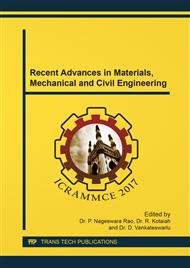p.3
p.13
p.20
p.26
p.33
p.39
p.44
p.50
p.54
Mesoporous Iron-Manganese Magnetic Bimetal Oxide for Efficient Removal of Cr(VI) from Synthetic Aqueous Solution
Abstract:
A facile co-precipitation method was established for synthesis of mesoporous iron-manganese magnetic bimetal oxide (MIMO) and its adsorption property was studied for removal of toxic metal ion hexavalent chromium from aqueous solution. XRD pattern of MIMO confirms the existence of Fe2O3 and Mn3O4 particle, out of which Mn3O4 is ferrimagnetic in nature. Synthesized MIMO has shown high saturation magnetization (23.08 emu/g), high BET surface area (178.27 m2/g) and high pore volume (0.484 cm3/g), which makes it a potential adsorbent. Adsorption process followed second order kinetic and Langmuir isotherm model. Involvement of intra-particle diffusion is also confirmed from kinetic data, which can be attributed to the mesoporous nature of the MIMO. Cr(VI) adsorption shows high pH dependency and maximum adsorption capacity of 116.25 mg/g is reported at pH 2.0. Electrostatic attraction between anionic chromium species and protonated MIMO surface is the predominant mechanism in this adsorption process.
Info:
Periodical:
Pages:
33-38
Citation:
Online since:
February 2018
Price:
Сopyright:
© 2018 Trans Tech Publications Ltd. All Rights Reserved
Share:
Citation:


